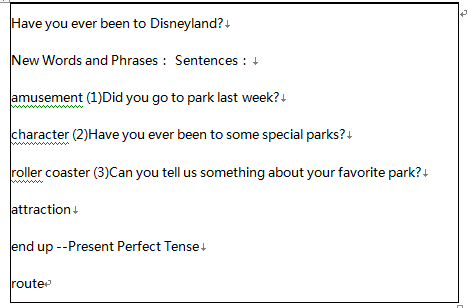根据下面题为Have you ever been to Disneyland?一文的内容,进行教材分析和处理,并回答下列问题。(中、英文均可)
1.确定这节课的具体教学目标。
2.确定这节课的教学重点和难点。
3.设计这节课的几个教学步骤(至少三个),并写出各教学步骤的主要内容及设计意图。
4.设计这节课对学生的评价方法。
5.写出这节课的板书设计。
教学材料:
八年级下册Unit 9 Have youever been to an amusement park?
Read this article about a theme park.Circle the places, things, and activities you think are interesting. Underline the ones you think are boring.
Have you ever been to Disneyland?
Most of us have probably heard of MickeyMouse and Donald Duck, and many other famous Disney characters. Perhaps we have even seen them in movies. But have you ever been to Disneyland? In fact, there are now several different Disneyland amusement parks around the world.
Disneyland is an amusement park, but we can also call it a theme park. It has all the normal attractions that you can find at an amusement park, but it also has a theme. The theme, of course, is Disneyland movies and Disney characters. For example, you can find a roller coaster in amusement parks, but in Disneyland, the theme of the roller coaster is Disneycharacters. This means that you can find Disney characters all over the roller coaster. You can also watch Disney movies, eat in Disney restaurants and buy Disney gifts. And you can see Disney characters walking around Disneyland all the time!
Have you ever heard of a Disney Cruise?These are huge boats that also have Disney theme.You can take a ride on the boat for several days, and you can sleep and eat on board. There are also many attractions on board, just like any other Disneyland, you can shop, go to Disneyland parties, and eat with Mickey Mouse! The boats take different routes,but they all end up in the same place. That is Disney′s own land.
It is just so much fun in Disneyland!
1.教学目标
(1) Knowledge objectives
① Students can master the new words and phrases, such as amusement, character, roller coaster,attraction, end up, route.
② Students can understand the Present Perfect Tense, and know how to ask and answer the sentence pattern "Have you ever been to ...?"
(2) Ability objective
Through group work,students can use the Present Perfect Tense to talk about their past experiencesin spoken conversation.
(3) Emotional objectives
① Students can get some ideas about the cultural differences between China and Western countries.
② Through talking about the places having been to, students can learn to care about others.
2.教学重点和难点?
(1) Teaching keypoints
① Words and phrases: amusement,character, roller coaster, attraction, end up, route.
② Grammar: PresentPerfect Tense
(2) Teaching difficult points
① How to use the Present Perfect Tense to talk about past experiences.
② How to identify the differences between Present Perfect Tense and Simple Past Tense.
3.教学步骤
Step 1 Lead-in (5min)
Use three questions to lead in the teaching topic:
(1) Did you go to park last week?
(2) Have you ever been to some special parks?
(3) Can you tell us something about your favorite park?
Through these three questions and answers, use the Simple Past Tense to lead out the Present Perfect Tense and the way of changing "be" into its Present PerfectTense form "been". Require students to answer the three questions and compare the differences.
(Justification:Create a sound atmosphere for the following teaching, and help to consolidatethe knowledge learned at the same time.)
Step 2 Presentation(15 rain)
(1) Ask students tofind out the new words and new phrases in this passage, and try to guess their meaning together.
(Justification:Through encouraging students to guess the meanings of new words, help students to raise a good study habit by thinking on their own.)
(2) Ask students to find sentences which are in a similar form/using the Simple Past Tense inpassage and try to understand them.
Then students look at the picture in the textbook, ask and answer conversations using ① ②sentence structures and then make affirmative or negative answers.
① "Did you ...?"
E.g. --Did you gotravelling this summer? --Yes, I did. / No, I didn't.
②"Have you ever been to ...?"
E.g. --Have you ever been to some special parks? --Yes, I have. / No, I haven' t.
(Justification:Through finding and analyzing the grammar points to help students understand the differences between Present Past Tense and Present Perfect Tense.)
Step 3 Consolidation(10 min)
Make sure students know the meaning of the new words and expressions. Before listening to the tape, give students several questions relating to the listening content.
Listen to the radio tape for 3 times. The first time, students just listen and try to know what it tells us; the second time, students finish the exercise in the textbook and try to answer the questions; the third time, check the answers.
(Justification: Through listening, help students to get the whole meaning of this new passage and consolidate the grammar point and new words.)
Step 4 Summary and Homework (5 rain)
(1) Review the Present Perfect Tense through "'ask and answer' method" to let students know how to describe the places they have been to.
(2) Translate the following into English.
①从没去过迪士尼乐园
②玩得偷快
③在同一个地方
④在船上
⑤行驶不同的路线
(3) Write a short passage to show the most special parks they have been to and report it to the class the next day.
(Justification: Help students to have a deeper memory of what have learned from this lesson, and learn to use them in real situation.)
4.评价方法
(1)在呈现环节中,学生进行问答对话后,教师针对学生的练习情况进行鼓励性的点评,鼓励学生多说多读英语。
(2)在巩固环节中,进行听力环节后,教师让学生自己检查答案,并进行自评,发现错误后及时反馈,及时改正。
5.板书设计

我国保护少年儿童权益的专项法律是《中华人民共和国未成年人保护法》。( )
MP3( )。
计算机软件是指( )。
下面哪一项不属于维护交易安全原则的内容?( )
围绕《建国以来的重大科技成就》一课,做一个教案。
请围绕“城乡发展一体化”写一篇小论文,题目自拟,角度不限,要求:结构完善、条理清晰、有说服力。
在国际关系中,第三世界国家历来是中国团结合作的对象,因为 ①第三世界国家是国际社会一支重要的政治力量 ②团结第三世界国家符合中国的国家利益 ③合作是第三世界国家共同发展的必由之路 ④第三世界国家在南北关系中处于主导地位( )
微观经济学要解决的问题是( )
机关文书部门或业务部门在年终或第二年上半年对归卷的文件材料进行整理等工作,称为( )。
20世纪70年代中国外交有了重大突破和转机,转变的关键是( )